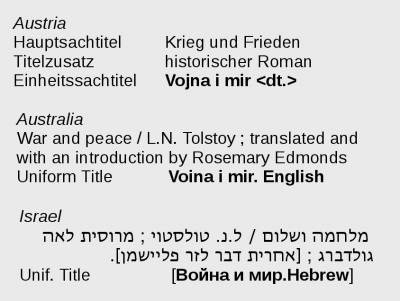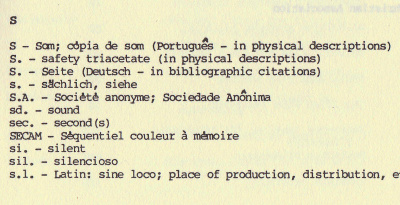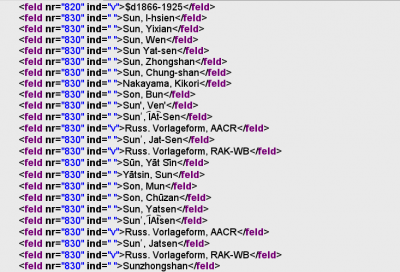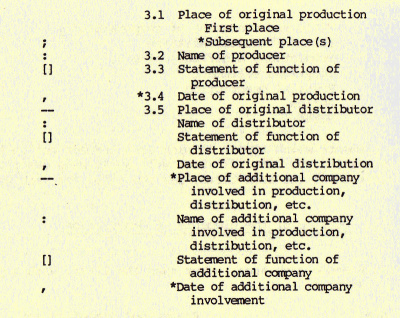Difference between revisions of "Titles and proper names"
From filmstandards.org
(→Why some conventions are more useful than others) |
(→Why some conventions are more useful than others) |
||
| Line 45: | Line 45: | ||
Moreover, databases can provide users with an unlimited number of access points which means that these do not have to be determined in advance. | Moreover, databases can provide users with an unlimited number of access points which means that these do not have to be determined in advance. | ||
| − | Where a uniform title serves the purpose of identifying a work existing in many manifestations, it corresponds to the ''identifying title'' in EN 15907. | + | Where a uniform title serves the purpose of identifying a work existing in many manifestations, it corresponds to the ''[[EN 15907 Identifying Title|identifying title]]'' in EN 15907. |
| + | |} | ||
| + | |||
| + | {| style="float: right; border: 1px solid #BBB; margin: .46em 0 0 .2em;" | ||
| + | |- | ||
| + | | valign="top" width="405px" |[[File:Isbd-punctuation.jpg|400px]]<br /> | ||
| + | <span style="font-size:8pt"> | ||
| + | From: FIAF Cataloguing Rules for Film Archives, 1991, p.4. | ||
| + | </span> | ||
| + | |||
| + | | valign="top" width="405px" | | ||
| + | '''Punctuation rules''' such as the ones adapted from ISBD by the FIAF Cataloguing Commission were adequate for situations in which encoding and display syntax were inseparable. | ||
| + | |||
| + | Using display-independent encodings such as in MARC or in XML or RDF-based metadata schemas, display formats '''can be generated''' as required for a particular purpose or audience. | ||
| + | |||
| + | Note that MARC is actually a hybrid encoding in that it allows punctuation syntax to occur within some tagged elements. | ||
| + | |} | ||
| + | |||
| + | |||
| + | {| height="20px" width="100%" | ||
| + | |- style="text-align:center; " | ||
| + | |<span style="color:#808080"> • Previous: [[Where to look for suitable element vocabularies]] • Up: [[TC 372 Workshop Compendium|Contents]] • Next: [[Example: Die freudlose Gasse]] • </span> | ||
| + | |- | ||
|} | |} | ||
Revision as of 11:10, 5 April 2011
From the TC 372 Workshop Compendium
Why some conventions are more useful than others
This is a classic domain of cataloguing rules. Many of the conventions laid down in compendia such as the AACR can be expected to remain useful in the future. Some, however have turned out to be less adequate for an all-digital, networked information environment.
 From searches via gateway: http://www.ubka.uni-karlsruhe.de/kvk.html |
Rules for uniform titles and for preferred names have been developed in the context of national bibliographic systems. When used internationally, these concepts become meaningless since each language community can (and often does) have its own preferences. Moreover, databases can provide users with an unlimited number of access points which means that these do not have to be determined in advance. Where a uniform title serves the purpose of identifying a work existing in many manifestations, it corresponds to the identifying title in EN 15907. |
| • Previous: Where to look for suitable element vocabularies • Up: Contents • Next: Example: Die freudlose Gasse • |


